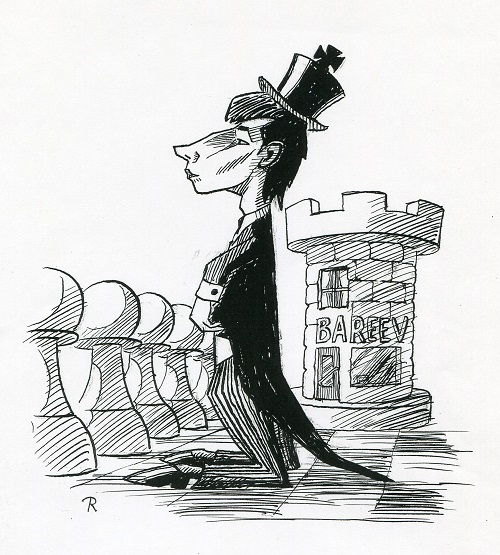
A kangaroo playing chess in a tuxedo? What am I supposed to make of that, Rupert? It’s playing with white, by the way, which is slightly contrary to the origin of the word ‘kangaroo’ – since ‘gangurru’ in fact means ‘black kangaroo…’ Alright then, Bareev. How often does it happen that your strongest memory of a player is a move made by one of his opponents? For me, that is the case with Bareev. Not his fantastic book From London to Elista about Vladimir Kramnik’s first three World Championship matches, which he wrote together with Ilya Levitov. Also, not his life-long loyalty to the French Defence. No, it is the move 20…Bd6-c7! from the game Bareev-Van der Sterren, Biel 1993. If you want to see what I mean, then please take hold of Van der Sterren’s book Zwart op wit, Verslag van een schakersleven (= Black on White, the account of a chess player’s life’) and turn to page 345. Read it and weep…
Bareev received his chess education at the Smyslov school in the former Soviet Union. Not that he was able to watch Smyslov from close by: he recalls seeing him only a few times during the five years he attended the school. The other coaches (among others, Dvoretsky and Razuvaev) were doing the real work. Bareev is very positive about the school – the Soviet Union was a land of long distances, and there are only few good coaches! His schooling quickly led to good results: in 1982 he won the World U16 Championship in Guayaquil. But after that it took him a relatively long time to become a grandmaster – not until 1989.
Just like Michael Adams, Bareev reached his peak in the 1990s and early 2000s. Twice he stood fourth in the world on rating, but he couldn’t achieve any real successes in the World Championship cycles. Only once did he make it to the final four: in the Candidates Tournament in Dortmund 2002. That is curious for such a strong player. I think that Bareev is more a tournament player than a match player: during a tournament, one defeat is not a disaster, but in the short World Cup matches, it is. He admitted this implicitly in his semi-autobiography titled Say No to Chess Principles!: ‘In all I played no fewer than five such knockout events, and was able to bounce back only a handful of times’…
Besides a top player, Bareev was also a successful second to Kramnik for the latter’s matches against Kasparov and Leko – from the white side, that is, and with the exception of the Grünfeld! Mostly he worked together with Joel Lautier, and curiously enough he found it especially pleasant to analyse in Paris. The fact that Kramnik hired him as a second was not unrelated to the fact that during his entire career practically Bareev’s only opening move has been 1.d4. His toughest task was doubtlessly before the final game in the match with Leko. Kramnik’s assignment was simple: refute the Caro-Kann by means of 3.e5… In fact, Bareev mainly played the French with black, but also the Caro-Kann, so he must have known where the painful areas were. Anyway, the rest is history: Kramnik won, and kept his title!
The way in which Bareev gives comments on games is quite typical. He doesn’t spare himself at all, but does it with so much humour that the conclusions get stuck in your mind. This absolutely applies to his autobiographical book. With themes like ‘A Queen behind enemy lines’ and ‘Killer delayed castling’ he explores the outlying areas of chess, where no principles have been discovered yet. Perhaps he hopes that, just like the players he mentions in his foreword – Alekhine, Capablanca, Spassky, Petrosian, Botwinnik and… Anand – he will later be admitted to the ranks of the classics! (PvV)